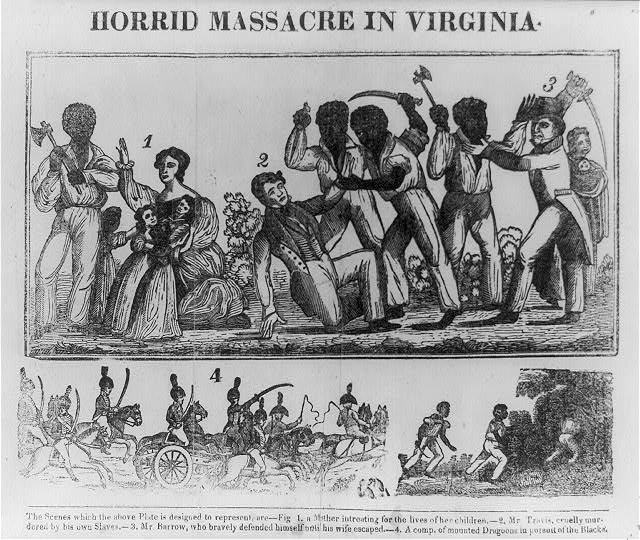
The Dr. Martin Luther King Memorial Commission of the Virginia General Assembly announced that it will spend taxpayer money to erect a statue honoring Nat Turner who was the leader of a drunken slave rebellion that massacred fifty-five whites in the Southeastern part of the state in 1831. Most of the victims were women and children hacked to death with hatches and axes. Thirty-one year old Turner was the slave of a white family headed by Joseph Travis whom Turner considered “a kind master.” Nonetheless, on Sunday 21 August Turner gathered six other male slaves in the woods near the Travis household where they feasted on roast pig and apple brandy. By mid afternoon he announced that the group would “rise that night to kill all the white people.”
About two o’clock Monday morning they sneaked into the Travis household and chopped all the family members to death, including an infant in its cradle. More murders continued throughout that night as the rebels took farm after farm by surprise. By sunrise the insurgents totaled fifteen when they made their first daylight attack, killing two women at their home. Soon thereafter they attacked the Caty Whitehead place where they dragged Mrs. Whitehead screaming into the yard to be beheaded. Her daughter tried to escape into the woods but Turner caught and killed the girl.
Next they assaulted the Nathaniel Francis home despite his reputation as a kindly white, further evidenced the several free blacks that chose to live on his property. Turner’s gang killed every white in the household including two boys. At the John Barrow farm, however, the patriarch fought back well enough to enable the females to escape.
By noon Turner had assembled about twenty black men, but several were put under guard as reluctant participants. Next, he sent a detachment to massacre the Parker family. When the men failed to return he took the rest of the gang to the Parker home where he found the detached group celebrating in the brandy cellar. Afterward Turner raided a few more farms, only to find them deserted. One was owned by a family named Thomas, which included a fifteen-year-old boy named George. Thirty-two years later as a major general George would win the nickname “The Rock of Chickamauga” for his role in saving the Union army during that Civil War battle.
By Monday afternoon a number of white families had banded together in organized resistance. They drove the blacks away at a skirmish near the Parker farm.
Tuesday morning Turner took his men toward a farm owned by Dr. Simon Blunt where he hoped to gain recruits. But the band rode into an ambush. Instead of joining Turner’s revolt, several of Blunt’s slaves helped defend the Blunt homestead and even captured a few of Turner’s rebels. By Tuesday evening Turner’s band was completely dispersed and a full scale manhunt for him was underway. He evaded the law until the end of October, when finally captured. Although some whites wanted to lynch him, he was given legal counsel and a trial that resulted in conviction.
Turner never expressed remorse for his actions and instead considered himself a martyr. (He had a multi-year history of bizarre religious delusions.) Turner was hanged on 11 November. Twenty-eight other blacks were also convicted. Eighteen were hanged and ten were “transported,” presumably out of the country.
Although Turner’s rebellion was suppressed within two days (by 24 August), false rumors of other uprising spread throughout the region for several more days. Consequently, a number of panicked whites hunted imaginary insurgents, which resulted in the arrest and even execution of some innocent blacks.






